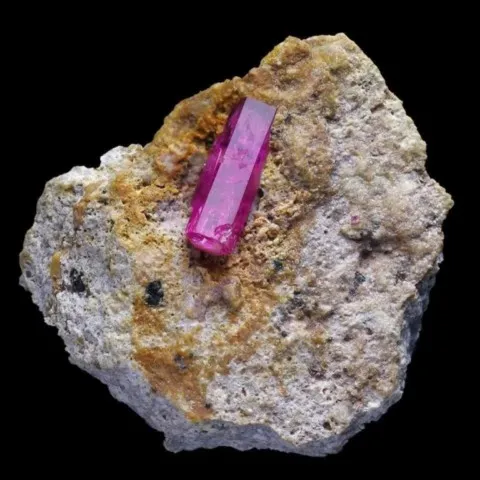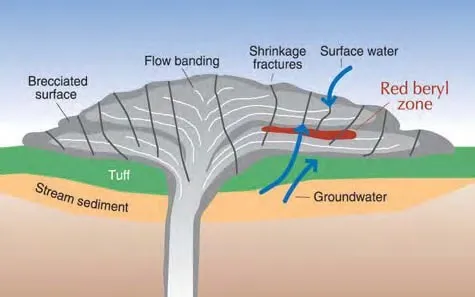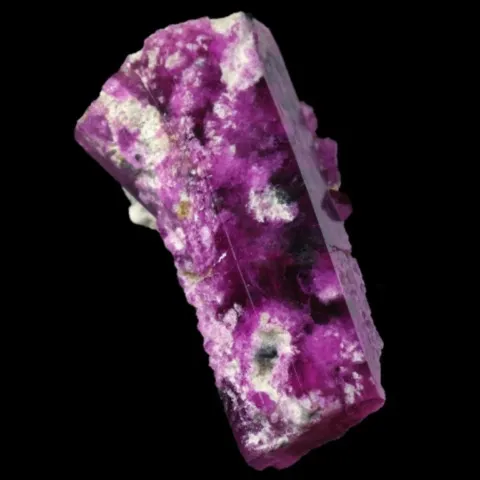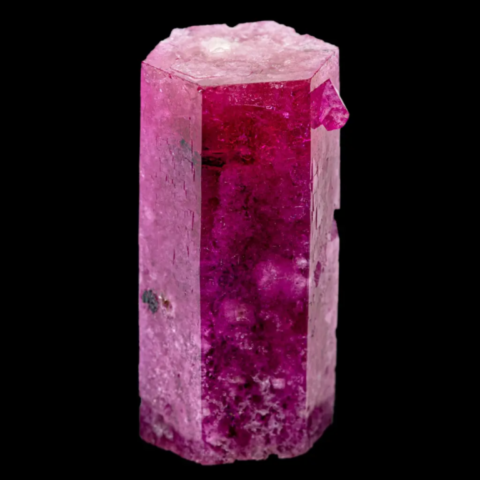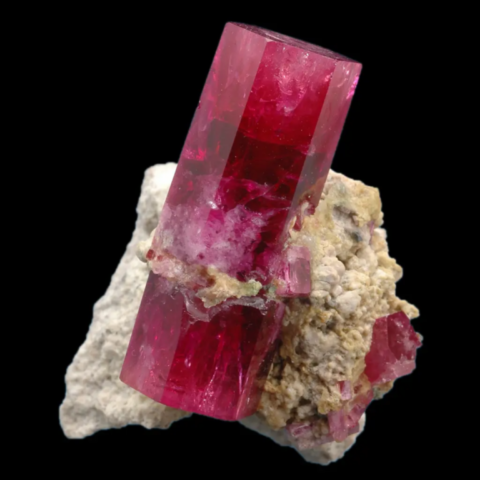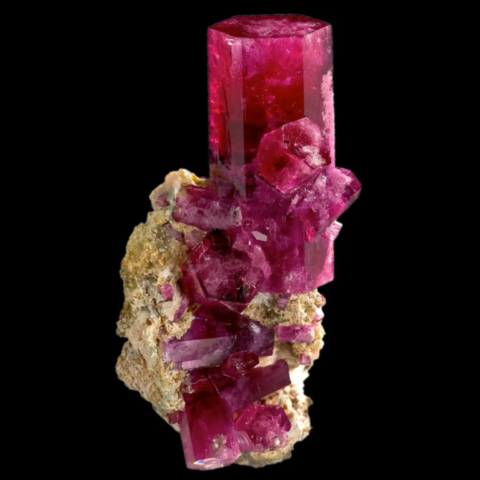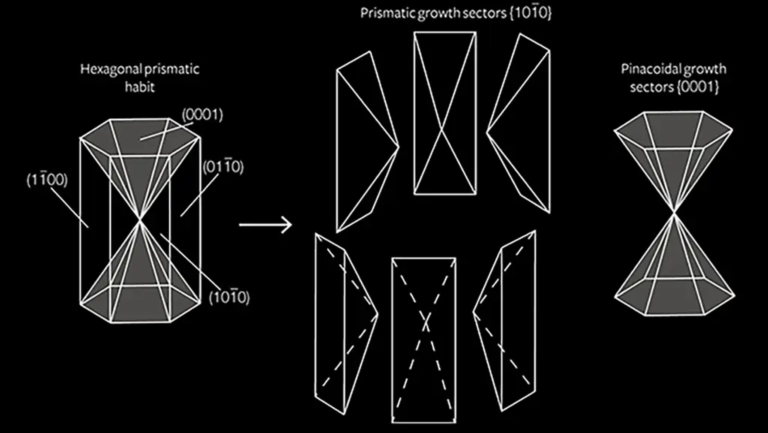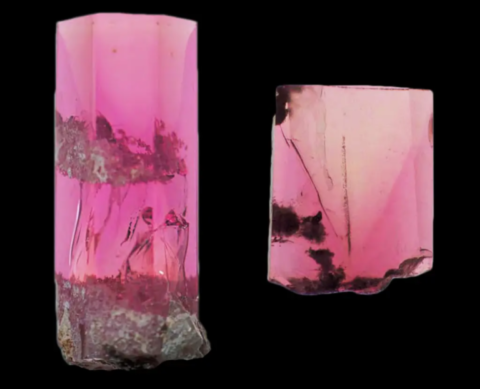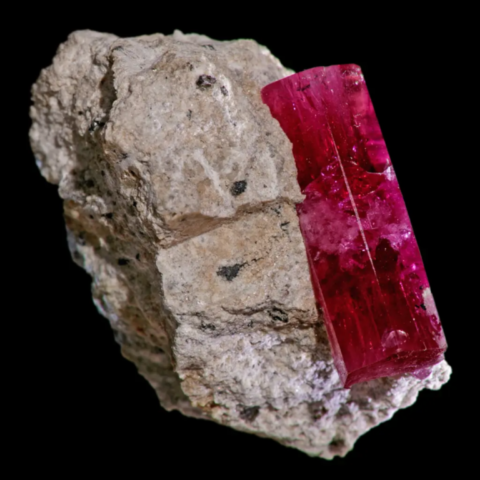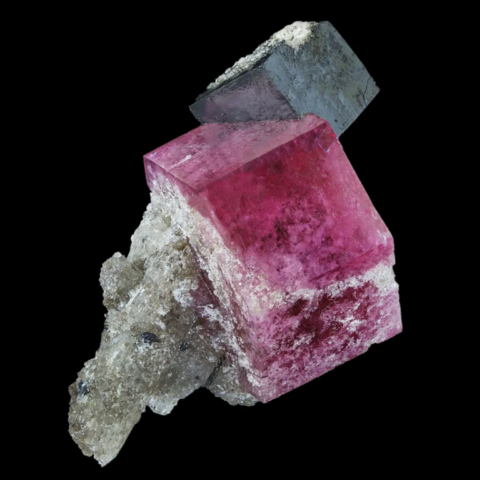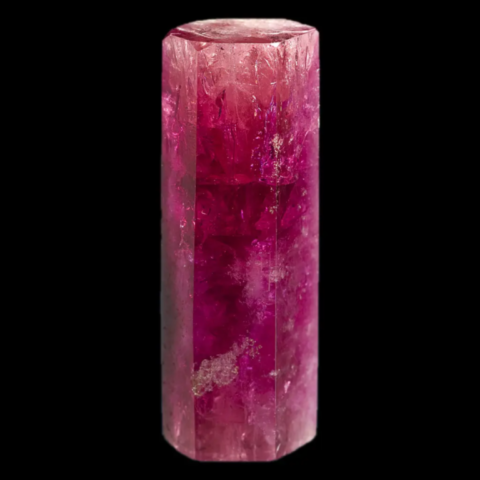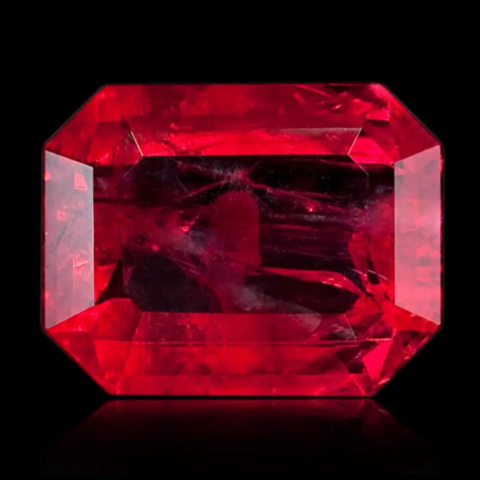Red beryls from Wah Wah Mountains, Utah
Red beryl, often referred to as "Utah's hidden treasure," is one of the rarest and most prized varieties of beryl in the world. This precious mineral is distinguished by its intense red color, due to the presence of manganese (Mn3+), and is mined primarily in the Wah Wah Mountains in Beaver County, Utah. Its extreme rarity, combined with its unique beauty, makes it a coveted stone for collectors and jewelers around the world.
Historically, red beryl was known as "bixbite," a term coined in 1912 by mineralogist Maynard Bixby, in honor of himself. However, this name quickly created confusion with another mineral called bixbyite, which occurs in the same geological contexts. Due to this similarity in names, the international community has preferred to use the term "red beryl," which is more descriptive and avoids any ambiguity.
The choice of the name "red beryl" also allows it to be linked to its mineralogical family, which includes famous varieties such as emerald (green beryl) and aquamarine (blue beryl). However, this designation has not prevented some marketing attempts to promote it under the name of red emerald, in reference to its value comparable to that of emeralds. Although this name has aroused the interest of consumers, it remains controversial and not officially recognized by gemological organizations, because it can mislead about the chemical and crystallographic identity of the mineral.
Photo : Red beryl on rhyolite from Violet claims, Beaver County, Utah, USA © Rémi Bornet
Geological context
The Wah Wah Mountains are located in a Basin and Range physiographic province, characterized by alternating mountain ranges and parallel valleys. This region is the result of significant tectonic extension during the Tertiary, which created normal faults and horst and graben structures. These tectonic dynamics influenced the formation of magmatic reservoirs that gave rise to Cenozoic volcanic eruptions.
The Wah Wah Mountains themselves are composed of Paleozoic and Mesozoic sediments, overlain by Cenozoic volcanic rocks, mainly rhyolites. These volcanic rocks, enriched in volatile elements such as fluorine, lithium and beryllium, provided an ideal environment for the formation of rare minerals such as red beryl.
These rhyolites were formed about 20 to 22 million years ago during intense volcanic activity. They are the result of explosive eruptions followed by the flow of viscous lavas. As they cooled, these lavas crystallized and contracted, forming fractures conducive to mineralization. The beryllium present in these rocks is essential for the formation of red beryl, which crystallizes in fractures filled with clay and other secondary minerals such as bixbyite, topaz, and iron and manganese oxides.
The geochemical conditions of these rhyolites, characterized by a low calcium content and an oxidizing environment, allowed the preservation of the trivalent form of manganese (Mn3+). The latter was transported by hydrothermal fluids. The oxidizing environment prevented the reduction of manganese to Mn2+, thus maintaining its trivalent valence, essential for the red coloration of beryl.
Figure : Geological section of the Violet Claims deposit, Utah, USA from SHIGLEY et al. (2003)
Genesis of red beryl
Red beryl was formed from fluorine-rich supercritical fluids released by rhyolitic magma as it cooled (pneumatolytic phase). A supercritical fluid is a state of matter where the temperature and pressure conditions exceed the critical point (374°C for water), giving the fluid properties intermediate between those of a liquid and a gas. This type of fluid is highly corrosive, capable of dissolving minerals and transporting chemical elements through rocks, and is called pneumatolysis.
These fluids reacted with pre-existing minerals and volcanic glass to crystallize red beryl along cooling fractures. This process took place at temperatures below 650°C but higher than those of later clayey alteration (200-300°C).
The distinctive red colour is due to the presence of manganese (Mn3+) in the crystal structure of beryl as a substitute for aluminium (Al). Manganese was introduced into the rhyolite by hydrothermal fluids rich in dissolved elements from both surface waters and underlying sediments. The low calcium content of the rhyolite also favoured the mobilisation of beryllium in the form of fluorine complexes, facilitating the crystallisation of red beryl rather than fluorite (CaF2).
Mining history
First described by Hillebrand in Juab County at Thomas Range in 1905, red beryls were not discovered in gem quality and good dimensions until 1958 in Beaver County at Violet Claims (90 miles south) by Lamar Hodges, a prospector searching for uranium.
In 1976, the Harris family acquired the mining rights to the Violet Claims site. For nearly two decades, mining was carried out on an artisanal basis, primarily in the spring and fall, due to extreme weather conditions. Annual production was limited, yielding 0.5 carats of facetable red beryl per ton of rock mined.
In the 1990's, Kennecott Exploration Co. conducted intensive exploration, estimating reserves at over a million tons of rock containing red beryl. Despite significant investment and attempts at industrial processes, mining has remained uneconomical due to the high costs and complexity of extraction. Techniques such as caustic fusion* have been tested to extract the crystals, but their costly implementation has limited their success.
Prospecting in the Thomas Range, particularly in the Topaz Valley, is now open to the public, but only with hand tools, after the Bureau of Land Management (BLM) revoked claims in this area. However, other areas of the Thomas Range remain private, and prospecting activities require permission from the quarry owners.
Photo : Violet Claims red beryl open pit mine, Utah, USA © Bob Drummond
*Caustic fusion is a chemical process used to dissolve refractory minerals that are difficult to process using conventional methods. It involves heating the mineral material with a strong alkaline agent, such as sodium hydroxide (NaOH) or potassium hydroxide (KOH), at high temperatures, often between 500 and 700°C. This process breaks down the rock matrix and releases elements or minerals of interest, such as red beryl.
Properties of red beryls
Wah Wah Mountains red beryl has a low refractive index (n = 1.560-1.570), a specific gravity of 2.65-2.72, and a pronounced pleochroism ranging from purple-red to orange-red. Its hardness is 7.5-8 on the Mohs scale, making it suitable for jewelry. Its conchoidal fracture and irregular fissuring can present challenges during cutting.
Special zoning of red beryls
Photos on the right : Hourglass zonations in red beryls from Wah Wah Mountains, Utah, USA © James Shigley
Inclusions in red beryls
A prestigious jewelry stone
The production of faceted red beryl is a complex process that begins with the careful selection of raw crystals extracted from mines. Due to the rarity and fragility of this mineral, only a very small proportion of crystals have the proper clarity, size and color to be faceted. The crystals are first examined to identify inclusions and internal fractures that could compromise the quality of the final stone. The cutting is then carried out by experienced lapidaries, who must take into account the pleochroism of red beryl in order to optimize the saturation of the color. The direction of the table and the orientation of the facets are strategically chosen to maximize the reflection of light. Due to the hardness of red beryl and its tendency to exhibit conchoidal fractures, the cutting requires great precision to avoid material loss. The resulting faceted stones are small, most weighing less than one carat, but their intense colour and rarity give them exceptional value on the gem market, which can fetch well over $50,000/ct. The largest known cut red beryl weighs over 8 ct.
Photo right : 2.44 ct faceted red beryl from the Wah Wah Mountains, Utah, USA © Bonhams
Conclusion
Unique in its rarity and beauty, Wah Wah Mountains red beryl is not only a natural wonder, but also a valuable testament to the complex geological processes that led to its formation. Its fascinating geological history, combined with its remarkable physical properties, makes it a favorite subject of study for geologists. Its exceptional gemological value lies not only in its vibrant color and rarity, but also in the difficulty of its extraction and cutting, which enhances its appeal to collectors and jewelers around the world. As a rare and iconic gem of Utah, red beryl continues to captivate the attention of gem enthusiasts and scientists alike, symbolizing the raw beauty and complexity of the natural processes that created it.
References :
BARLOW J.F. (1979) Red beryl of the Wah Wah's. Lapidary Journal, Vol. 32, No. 12, pp. 2540-2570.
HILLEBRAND W.F. (1905) Red beryl from Utah. American journal of Science, 4th series, Vol. 19, pp. 330-331.
RAKOVAN J., KITAMURA M., TUMADA O. (2006). Sakura ishi (cherry blossom stones): Mica pseudomorphs of complex cordierite-indialite intergrowths from Kameoka, Kyoto Prefecture, Japan. Rocks and Minerals, Vol. 81, No. 4, pp. 284–292
SHIGLEY, J. E., & FOORD, E. E. (1985). Gem-quality red beryl from the Wah Wah Mountains, Utah. Gems & Gemology, Winter 1984, 208-220
SHIGLEY, J. E., THOMPSON, T. J., & KEITH, J. D. (2003). Red beryl from Utah: A review and update. Gems & Gemology, Winter 2003, 302-313.

